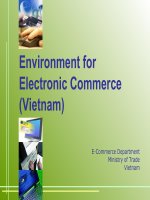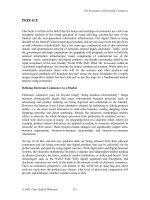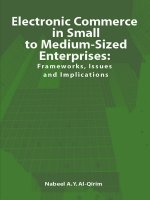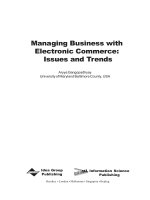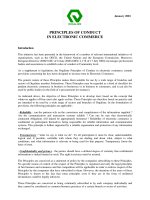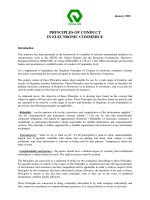Electronic commerce fundamentals ch9
Bạn đang xem bản rút gọn của tài liệu. Xem và tải ngay bản đầy đủ của tài liệu tại đây (675.71 KB, 36 trang )
Chapter 9
9
Strategies for Purchasing
and Support Activities
Electronic Commerce
1
Objectives
◆
◆
9
◆
◆
◆
Improving purchasing, logistics, and other
support activities
Creating network organizations that extend
beyond traditional limits
EDI, how it works, and how it is moving to the
Internet
Internet improvements to supply chain
management
Software packages for business-to-business
e-commerce and supply chain management
2
Purchasing, Logistics, and
Support Activities
◆
Purchasing activities
● Identifying
and evaluating vendors
● Selecting specific products
● Placing orders
● Resolving issues after receiving the
ordered goods or services
9
◆
Specialized Web sites exist that offer
high levels of product knowledge
3
Neoforma Product Sourcing Web Site
Figure 9-1
9
4
Logistic Activities
Providing the right goods in the right
quantities in the right place at the right
time
◆ Managing the inbound movements of
materials and supplies and the
outbound movements of finished goods
and services
◆
9
5
Support Activities
◆
Includes the general categories of
● Finance
9
◆
Making payments, processing customer
payments, budgeting and planning
● Human
◆
and administration
resources
Hiring, training, evaluating employees, benefits
administration
● Technology
◆
development
Networking, published research, connecting
outside sources of R&D services
6
DigitalWork Small Business Support Activities Page
Figure 9-2
9
7
Electronic Data Interchange
◆
9
◆
◆
The computer-to-computer transfer of
business information between two
businesses that uses a standard format
In the 1950s, companies began to use
computers to store and process internal data
and information
By the 1960s, companies began exchanging
transaction information with each other on
punched cards or magnetic tape
8
Electronic Data Interchange
◆
9
◆
◆
Eventually, trading partners transferred data
over telephone lines instead of shipping
punched cards or tapes to each other
In 1968, the Transportation Data Coordination
Committee was formed, charged with exploring
ways to reduce the paperwork burden
Since 1918, the American National Standards
Institute (ANSI) became the coordinating body
for standards in the United States
9
Electronic Data Interchange
◆
9
◆
In 1979, ANSI charted the Accredited
Standards Committee X12 (ASC X12) to
develop EDI standards
The current ASC X12 standard includes
specifications for several hundred transaction
sets (the names of the formats for specific
business data interchanges)
10
Commonly Used ASC X12 Transaction Sets
Figure 9-3
9
11
Electronic Data Interchange
In the mid-1980s, the United Nations
Economic Commission for Europe built
a common set of EDI standards based
on the American model
◆ In 1987, the EDI for Administration,
Commerce, and Transport (EDIFACT,
or UN/EDIFACT) was developed
◆
9
12
Commonly Used UN/EDIFACT Transaction Sets
Figure 9-4
9
13
Paper-Based
Purchasing Process
Paper-based purchasing process
results in a paper document created at
each information processing step that
must be delivered to the department
handling the next step
◆ Paper-based transfers between buyer
and vendor can be delivered via mail,
courier, or fax
◆
9
14
The Paper-Based Purchasing Process
Figure 9-5
9
15
EDI Purchasing Process
Mail service is replaced with the data
communications of an EDI network
◆ Flows of paper have been replaced
with computers running EDI translation
software
◆
9
16
The EDI Purchasing Process
Figure 9-6
9
17
Value Added Networks
◆
9
Trading partners can implement the
EDI network and EDI translation
process in several ways, each using
one of two basic approaches
● Direct
connection
● Indirect connection
18
Direct Connection Between
Trading Partners
Requires each business in the network
to operate its own on-site EDI translator
computer
◆ EDI translator computers are connected
to each other using modems or
dedicated leased lines
◆ Trading partners using different
protocols can make direct connection
options difficult to implement
◆
9
19
Indirect Connection Between
Trading Partners
Companies use the services of a valueadded network (VAN)
◆ The VAN provides communications
equipment, software, and skills needed
to receive, store, and forward electronic
messages containing EDI transaction
sets
◆ The VAN often supplies the software
needed to connect to its services
◆
9
20
Direct Connection EDI vs. Indirect Connection EDI
through a VAN
Figure 9-7
9
21
Advantages of Using a
Value Added Network
◆
9
◆
◆
◆
Users support only one communications
protocol
The VAN records activity in an audit log,
providing an independent record of
transactions
The VAN can provide translation between
different transaction sets
The VAN can perform automatic compliance
checks to ensure the transaction set is in the
specified EDI format
22
Disadvantages of Using a
Value Added Network
◆
9
◆
◆
Most VANs require an enrollment fee, a
monthly maintenance fee, and a transaction
fee
VANs can be cumbersome and expensive for
companies with trading partners using
different VANs
Inter-VAN transfers do not always provide a
clear audit trail
23
EDI on the Internet
Viewed as a replacement for expensive
leased lines and dial-up connections
◆ Small companies can get back in the
game of selling to large customers the
demanded EDI capabilities of their
suppliers
◆ Concerns about security and lack of
audit logs continue to be a major
roadblock
◆
9
24
Open Architecture
of the Internet
◆
9
The open architecture of the Internet
allows trading partners virtually
unlimited opportunities to customize
their information interchanges
25

